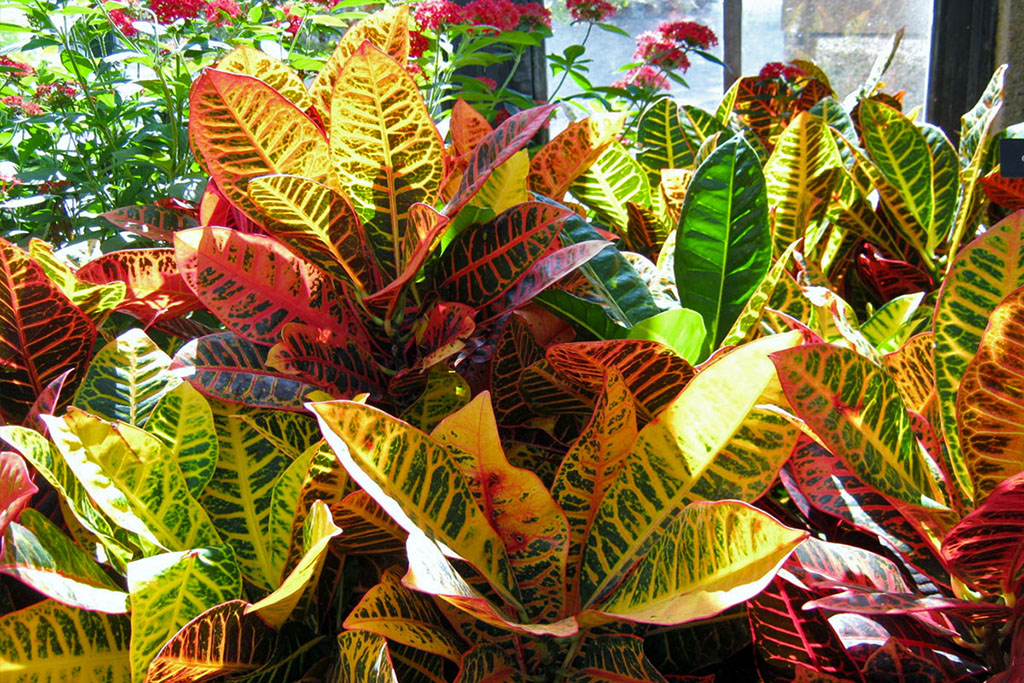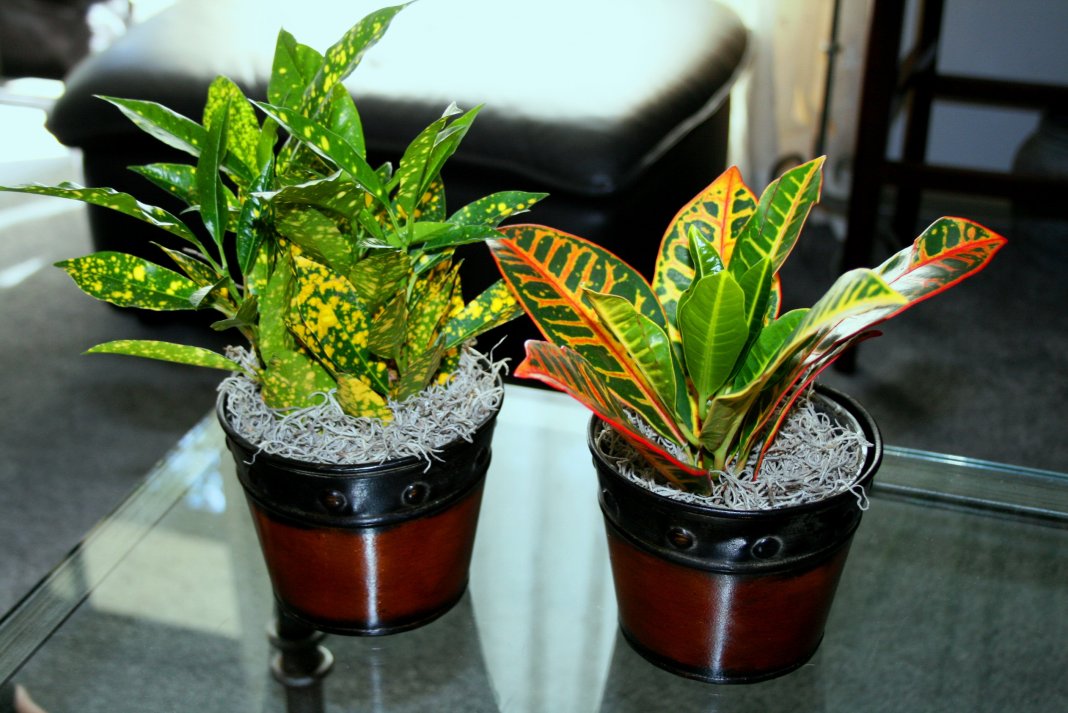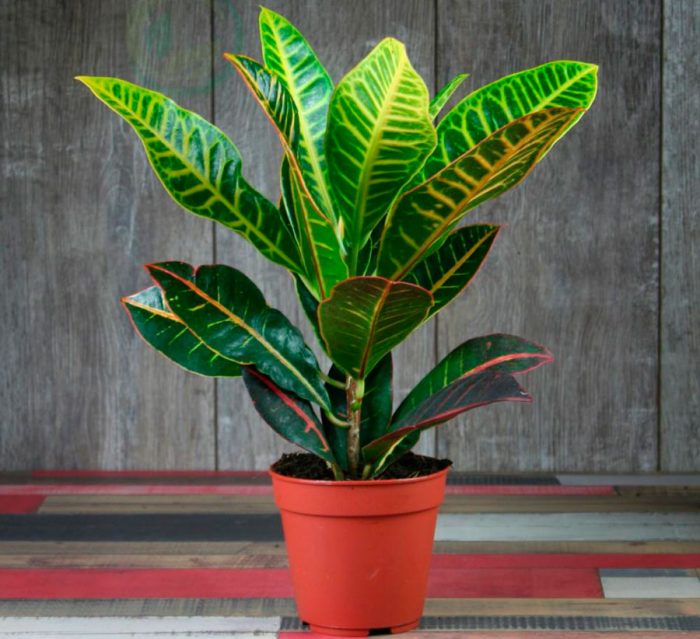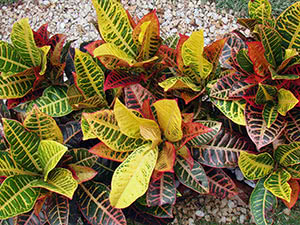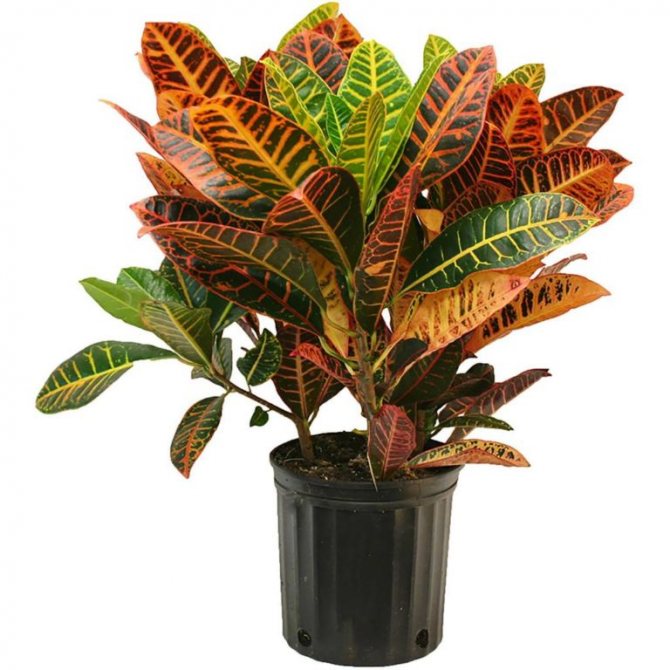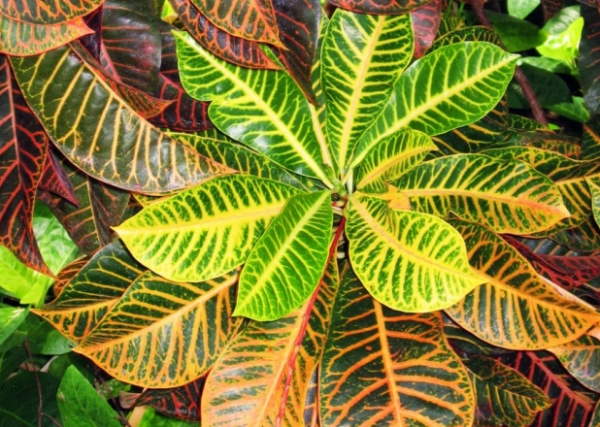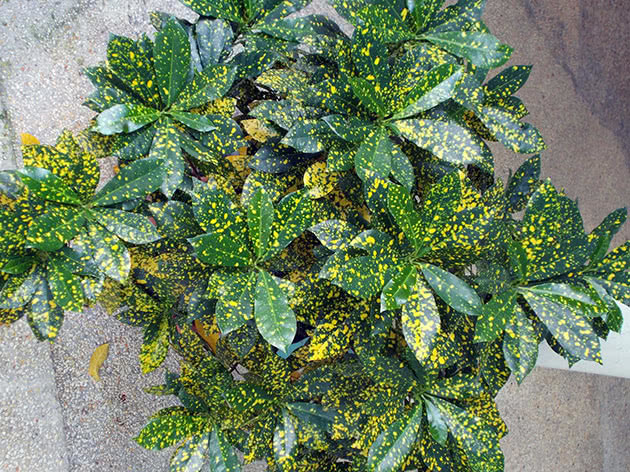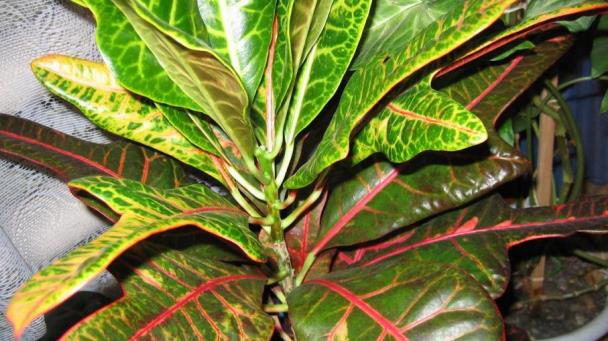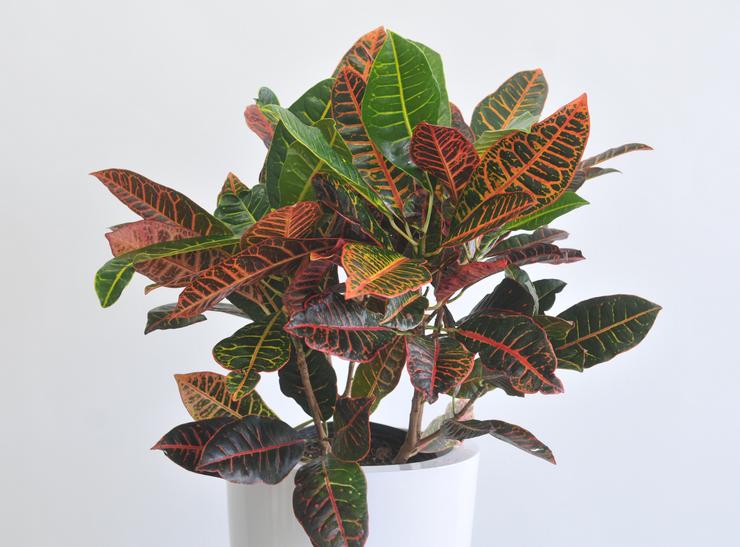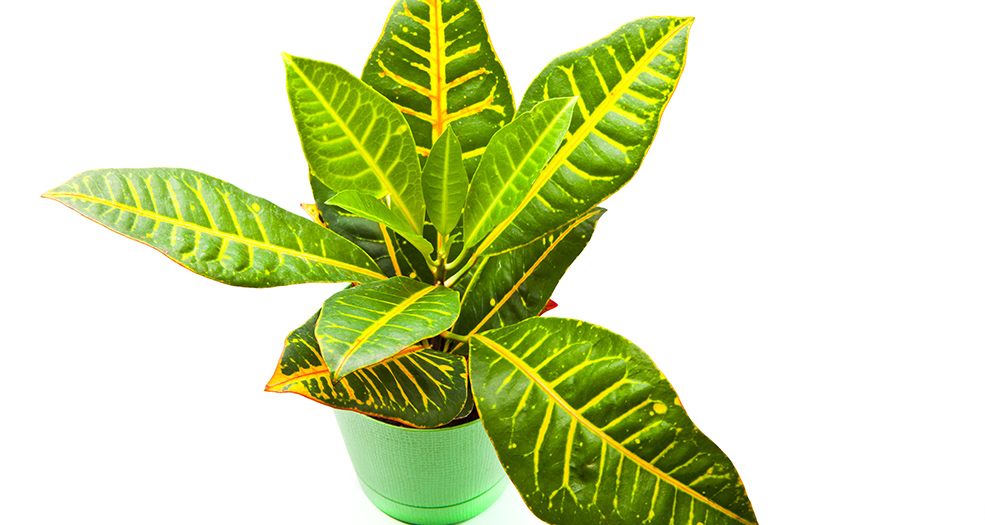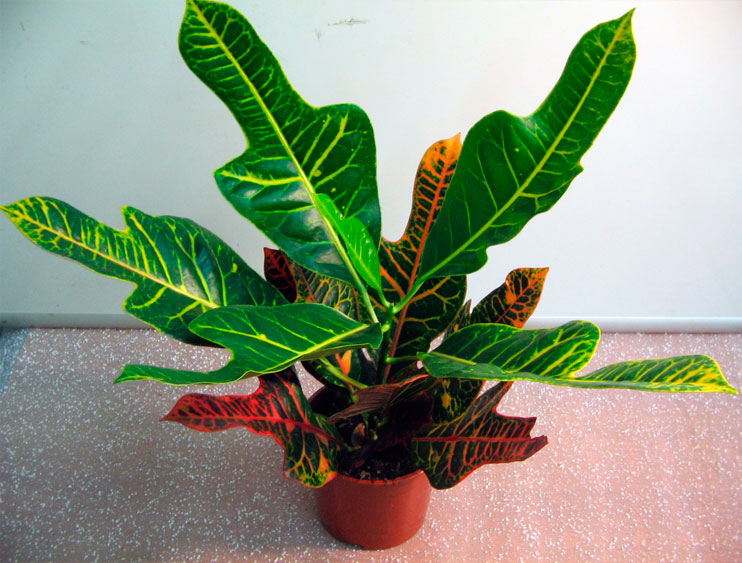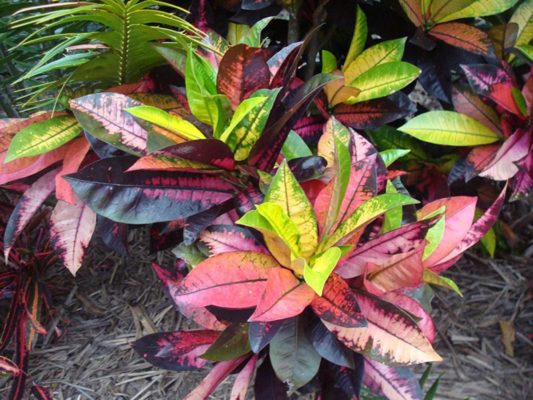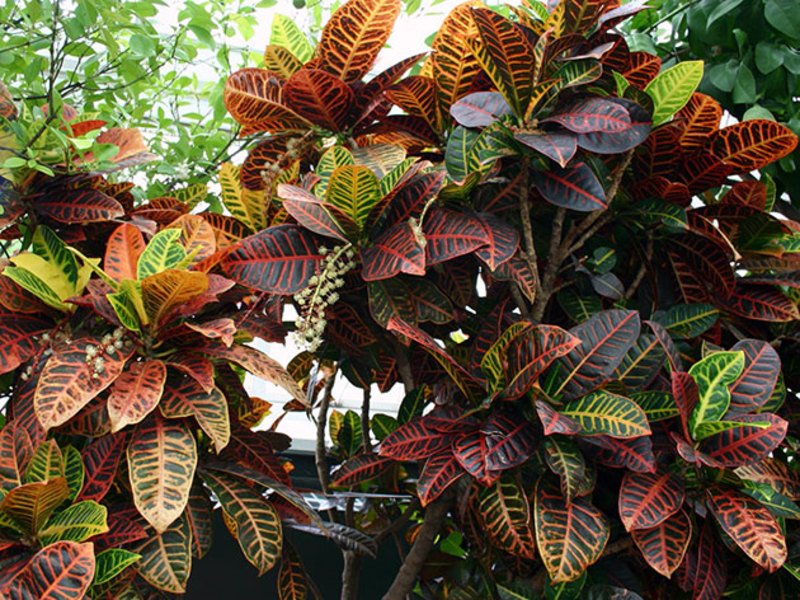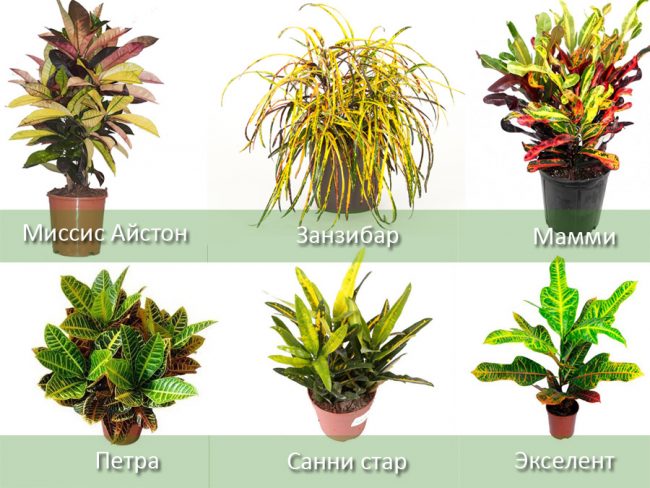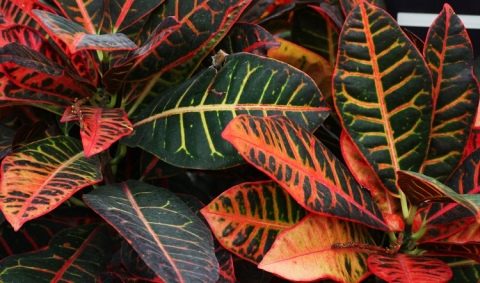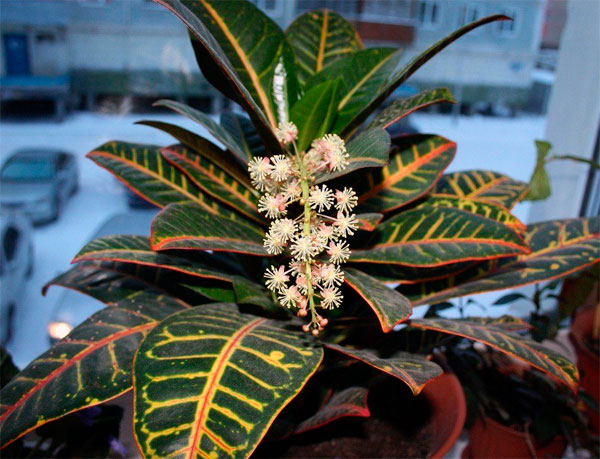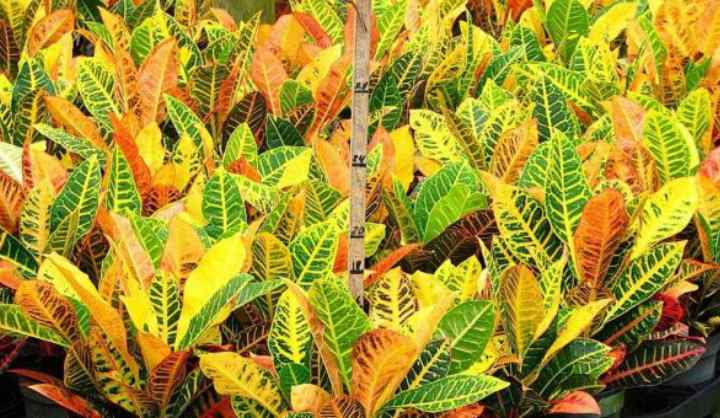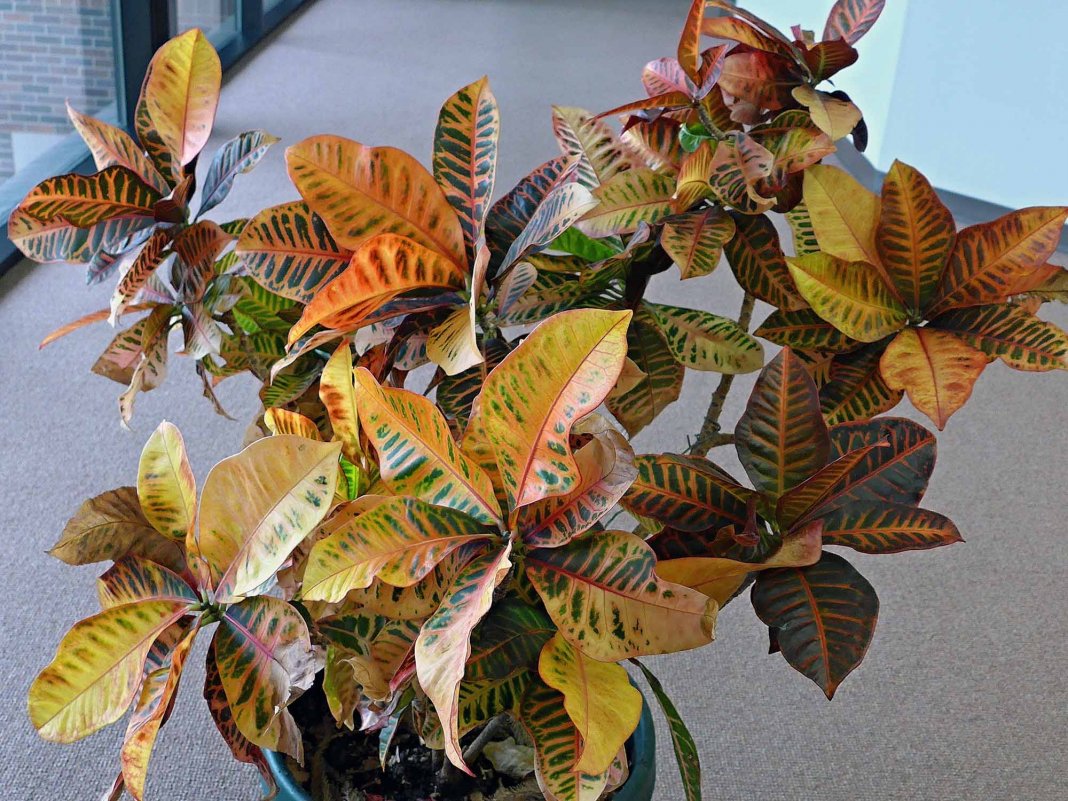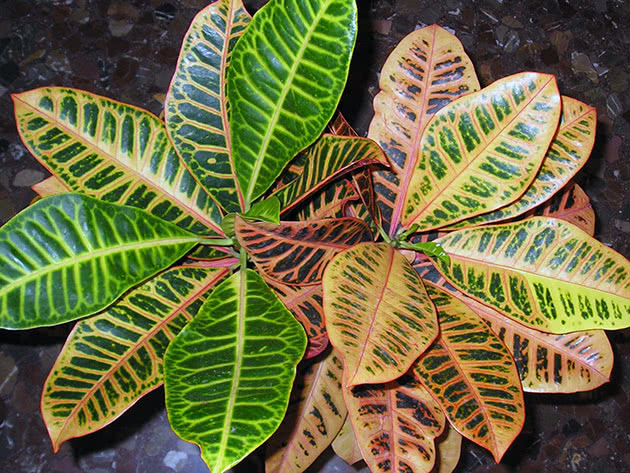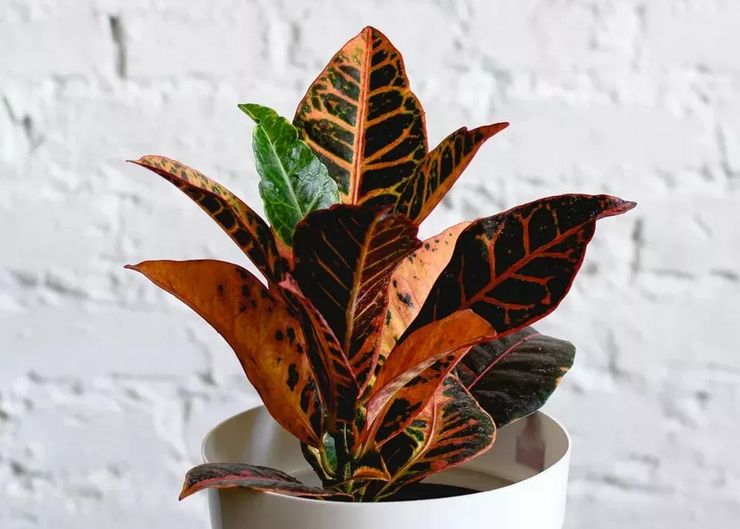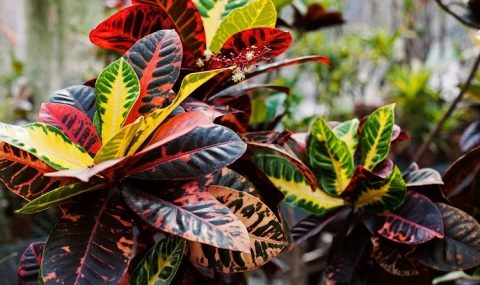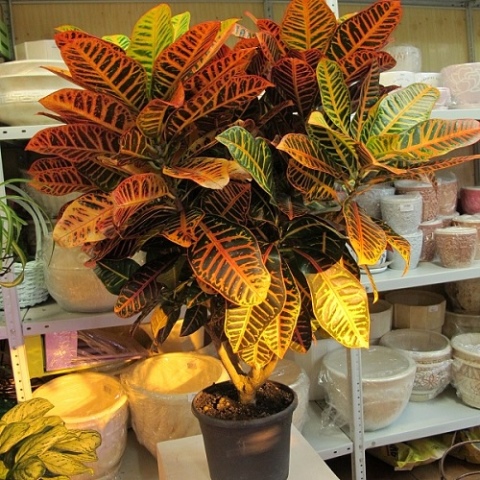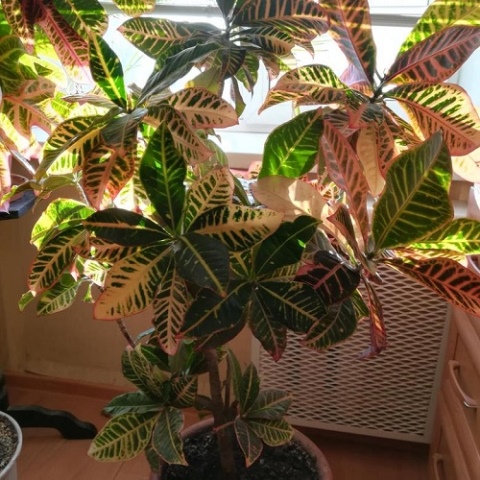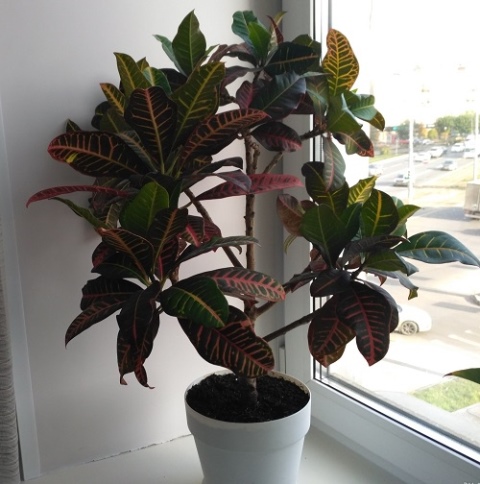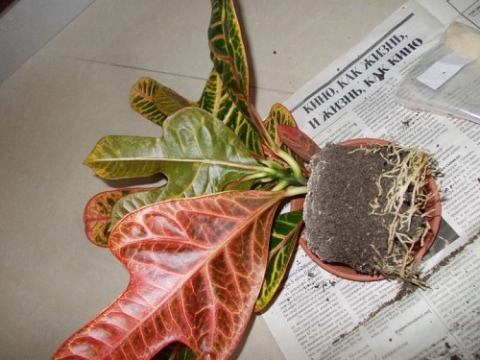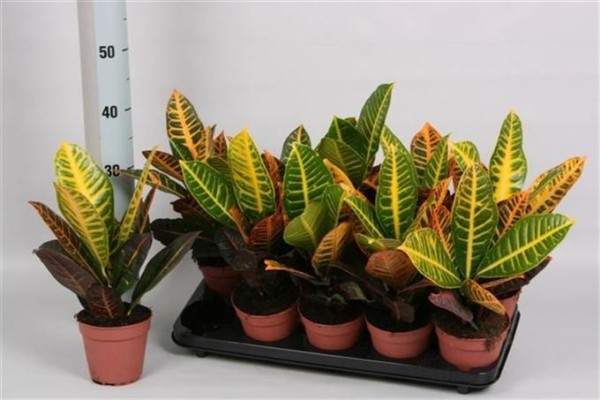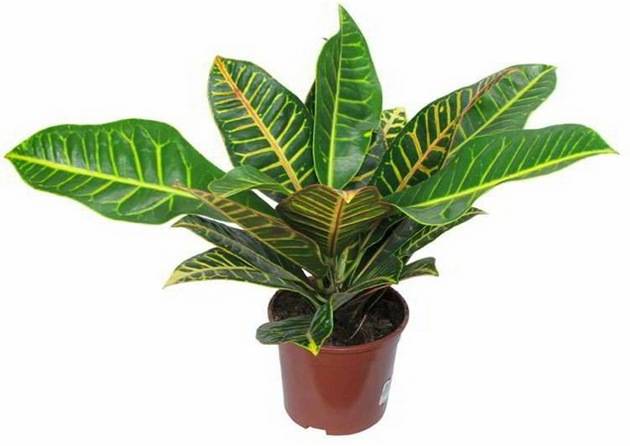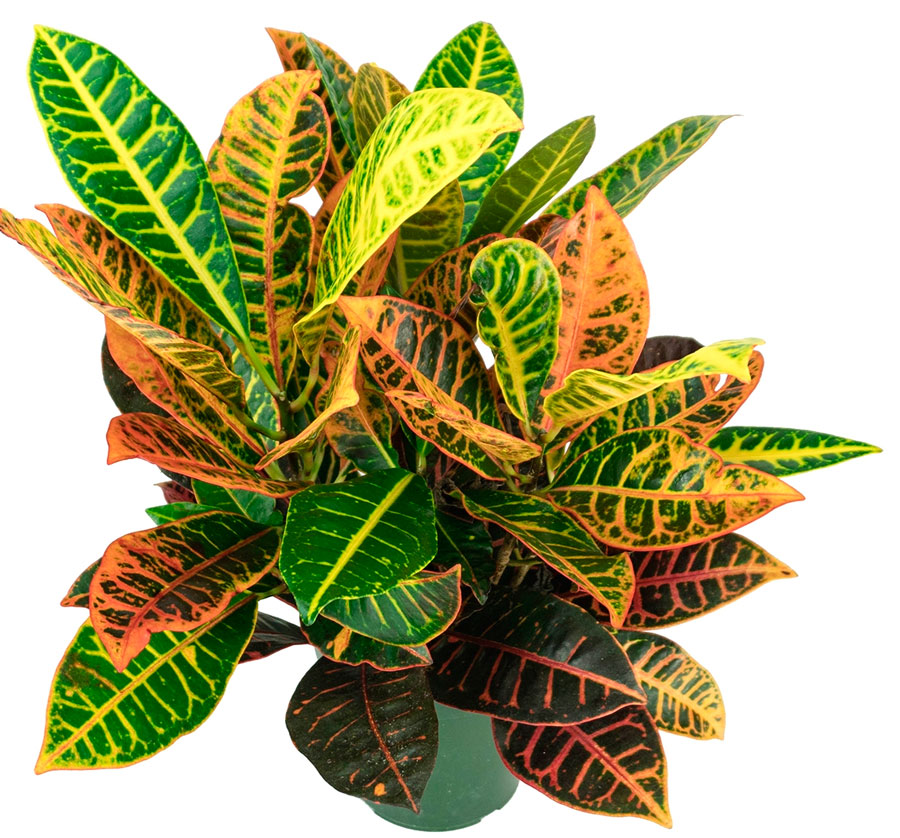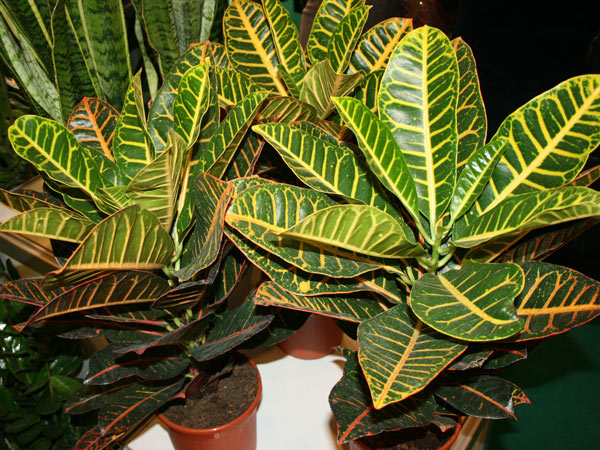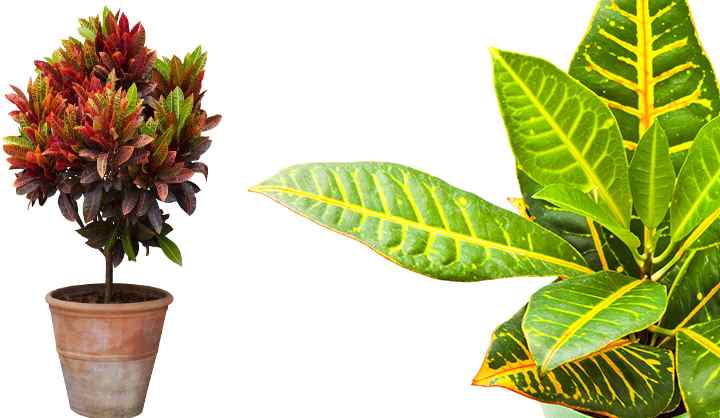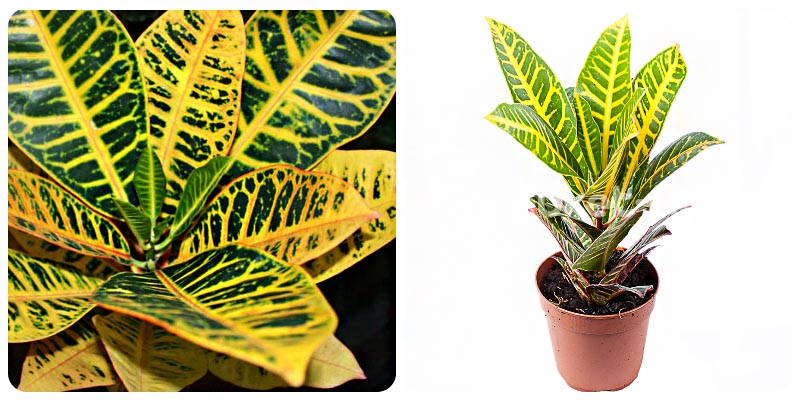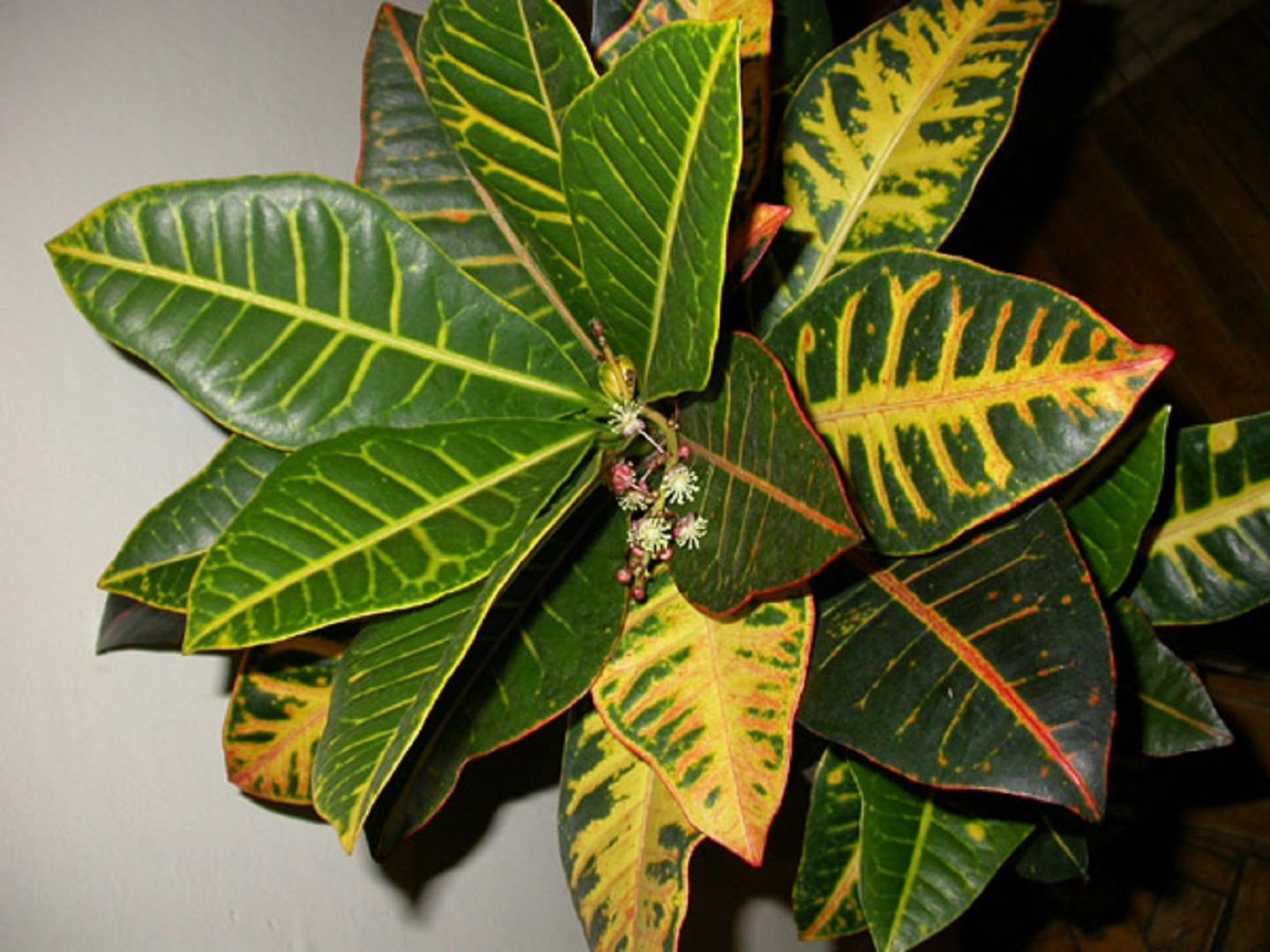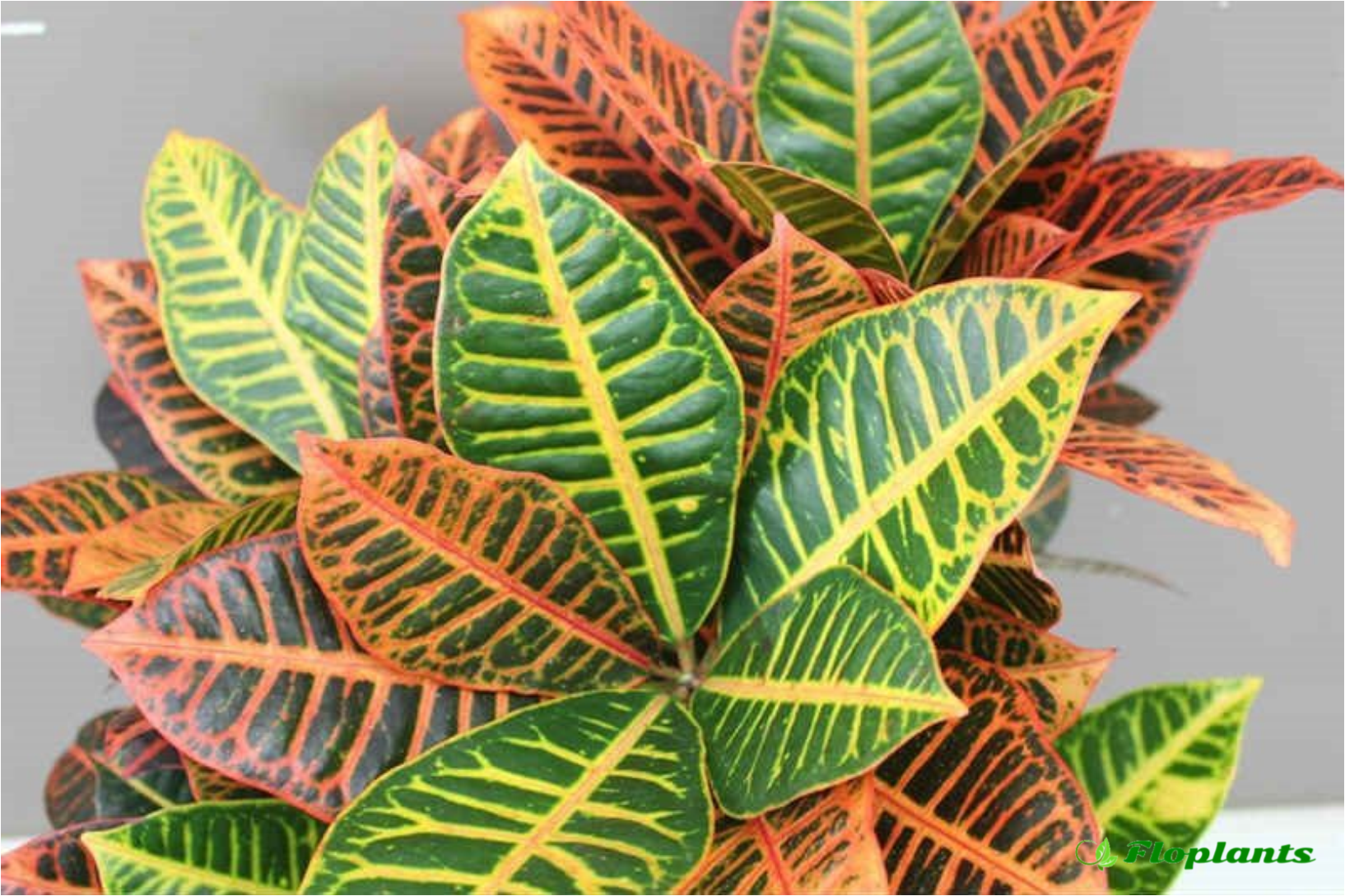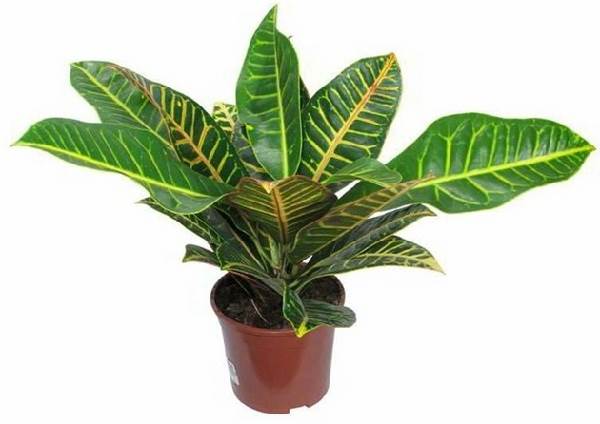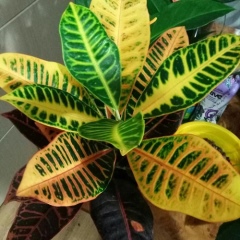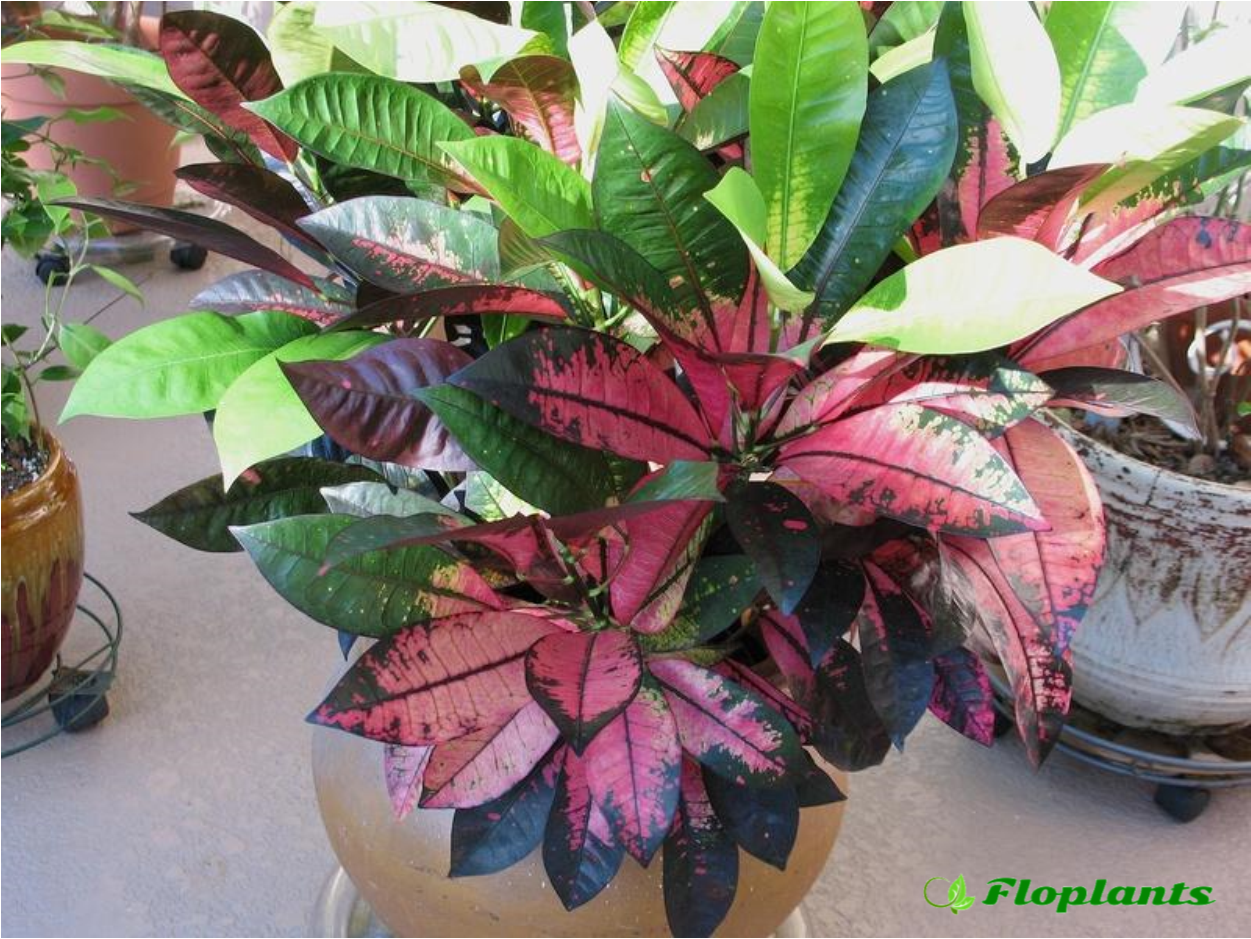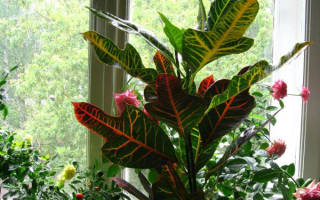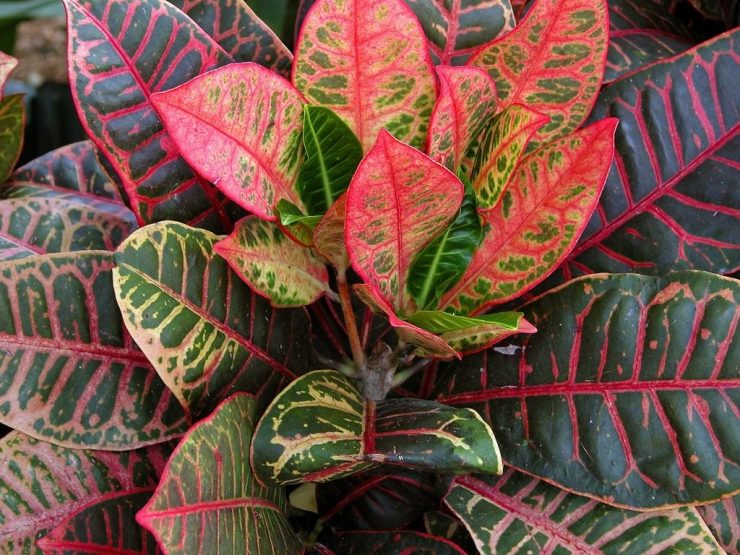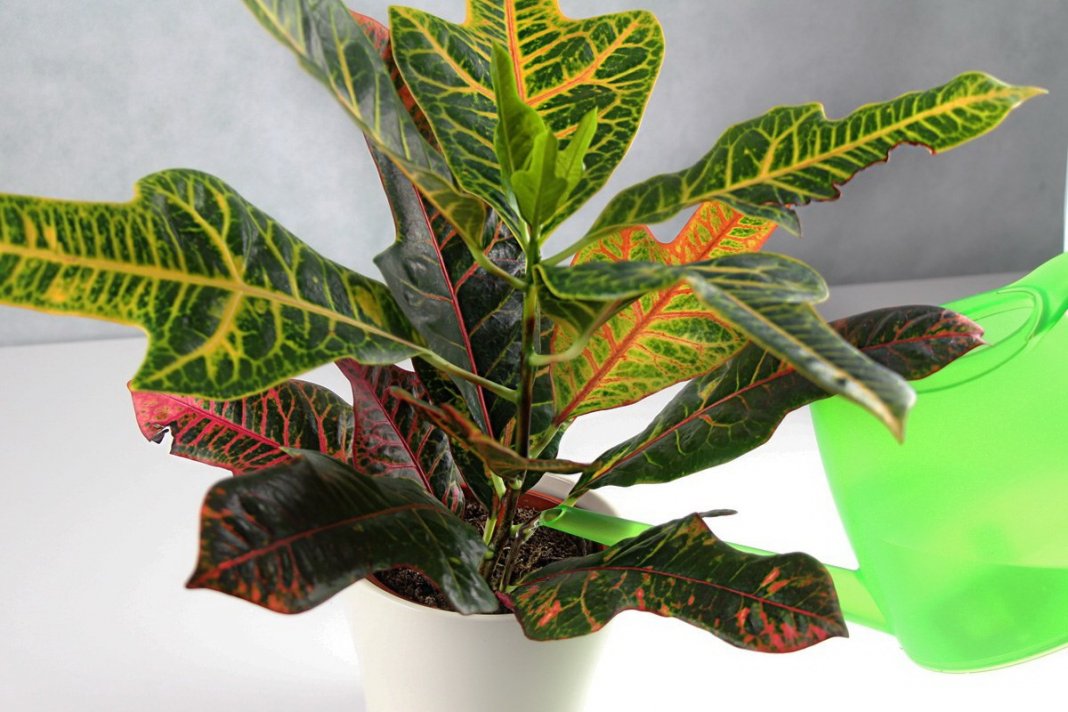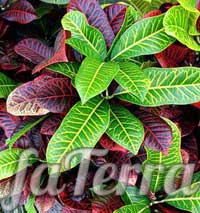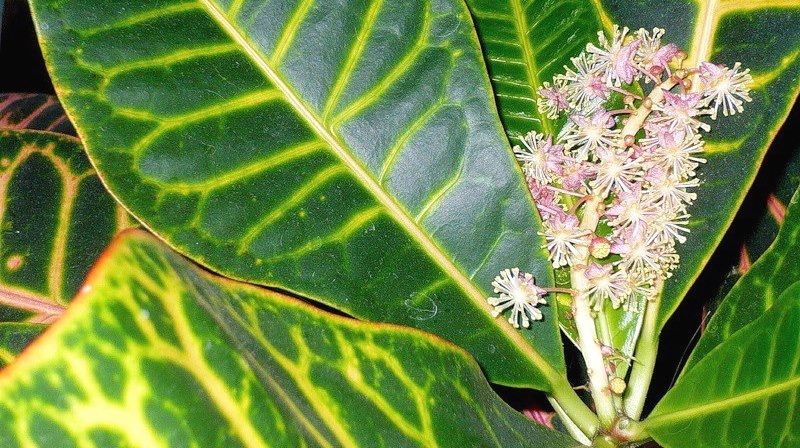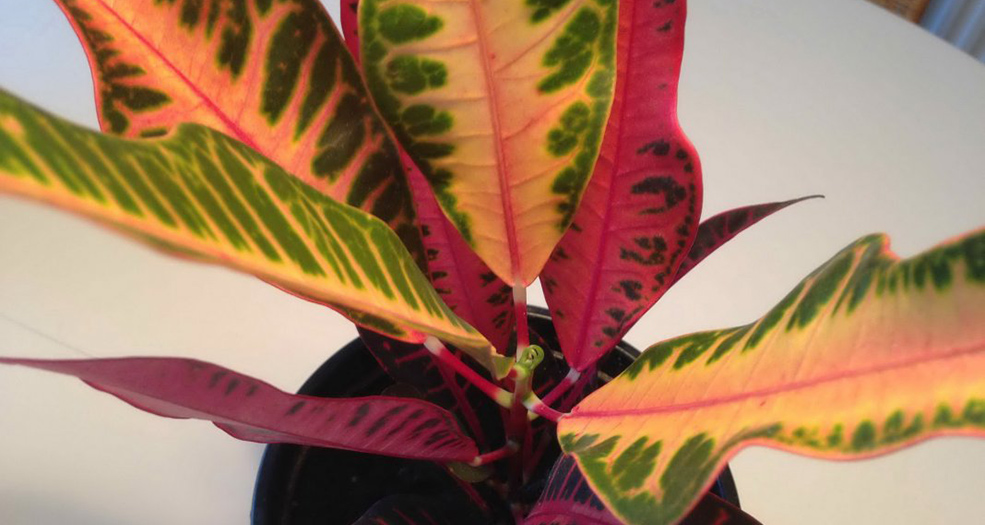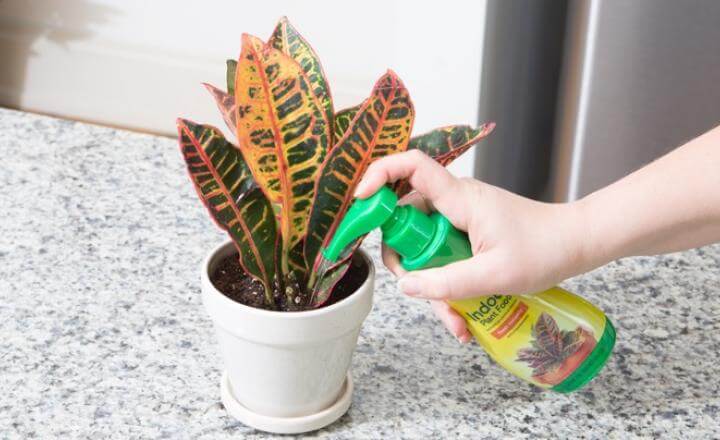We take care of all the rules
Codiaum is a capricious plant; when grown at home, it will need constant, proper care.
You need to plant a picky green inhabitant in a nutritious soil. The introduction of peat and complex fertilization is considered an excellent start. Stagnant water can destroy the root system and lead to the death of the plant.
An important condition for maintenance is wiping dust on leaves and on window panes. She blocks the path of the sun's rays.
Drafts should be avoided when choosing a location. You might well think that Codiaum, being a tropical plant, would not be able to exist in our climate and air temperature. As it turned out, this is not at all the case.
Motley codiaum (varigatum) Petra: home care

Codiaum motley (varigatum) Petra
The flower Codiaum Petra is considered a symbol of the hearth. They say it protects from the evil eye. In wildlife, it is common in tropical countries: Indonesia, India, Australia, the jungles of Malaysia. Shrubs grow up to 2.5 meters, trees up to 6 meters. At home, it is small, only 50-70 cm. The name of the codiaum is due to the Greek language, which means "head" in translation. Indeed, it resembles a thick, as if disheveled, head of hair. The leaves of the variegated codiaeum are leathery, large, up to 30 cm long, multi-colored. Veins against a greenish background are pronounced, they can be yellow, red, burgundy, which makes the flower bright and variegated, like a forest touched by early autumn wilting. Leaves in codiaum species can be sharp, like tongues, oval, scapula, simply elongated in length. Peter's codiaum blooms rarely, the type of inflorescences is inconspicuous, small.
Belongs to the codiaum species, the euphorbia family. The juice, like all milkweed, is poisonous. Be careful.
There are several varieties of codiaum: Vilma, Batik, Mummy, Gold, Excellent, Sunny Star. Codiaum (variegated) varigatum is usually called Peter's croton. Probably simplifying because of the complex, difficult to pronounce name. And it's hard to remember him. From the point of view of biological science, this is wrong. Croton and variegated codiaeum are completely different types of plants. Croton includes 1200 species, codiaum - only 17.
Confusion does not significantly affect the care and maintenance of plants, since the conditions of existence in nature for species are practically the same.
At first glance, it seems that a plant with such large, healthy leaves is unpretentious, but the opinion is deceptive. Codiaum varigatum is capricious and requires careful maintenance. Does not tolerate drafts, at the slightest breeze immediately reacts to discomfort, shedding leaves. The codiaeum of Peter reacts poorly to dry air, dust, direct sunlight, cold. They are fed all year round with organic matter and complex fertilizers: in winter - once a month, in the off-season - once a week.
Watering. A tropical child loves warmth and moisture. It is advisable to spray the leaves with settled water at room temperature daily, wash at least twice a week, send them to the shower once a month, put them under running water.
Lighting. Prefers bright, diffused light, direct sunlight is harmful to him. It is better to put the flower near the windows on the east and west sides. In the north, it simply does not have enough light, then the leaves will eventually lose their unusual color.
Temperature. Does not tolerate drops. In summer he feels good at 20 - 24, in winter - at least 18 degrees Celsius. In autumn and winter, it is better to place a flower pot next to a radiator.
Transplant and pruning. Needs an annual transplant. The pot is selected close, slightly wider than the previous one. The soil is prepared in advance.Sand, peat, humus, earth with a leaf, turf are mixed in equal proportions. The bottom is covered with drainage (pebbles, expanded clay, fragments of tiles, bricks). They clean the roots of the old soil, put it in a pot, cover it with new soil and crush it on the sides. Be sure to watered abundantly. In the spring, when the variegated codiaum grows, lateral shoots are partially removed. If there are no branches, pinch the top. Codiaeum pictum reproduces well by grafting. For this, cut stems and tops are used.
The motley codiaum (varigatum) of Peter can be bought in the stores of St. Petersburg. Prices and characteristics are shown in the catalog.
Appearance and general description
So, to convince you that your houseplant is most likely not a croton, let's start by looking at how it should look.
This wild plant belongs to the Euphorbia family. In the wild, it is represented by trees, shrubs, or common herbaceous plants. Visually, the plant seems grayish due to the fact that the leaves and flowers are covered with hairs or scales.
The leaves are whole, rather large. One of the features of the plant is the unusual color of the foliage: the leaves can be green, light green or red-brown, and also have many veins that stand out against the background of the leaf plate.

Now let's move on to describing the colors. How does croton bloom? Croton bloom is not uncommon. This plant blooms with monoecious flowers, which, as a rule, do not grow one by one, but fold into complex inflorescences.
The size and appearance of croton flowers depend on the specific type of this plant - as already mentioned, it is represented by trees, shrubs, and just herbaceous plants.
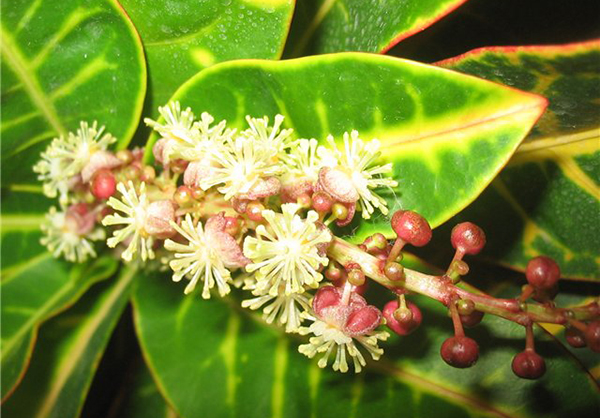
There are about 450 varieties of this flower, and croton can also be poisonous. However, there are also many specimens that are absolutely harmless to humans, and in some cases it is even used in medicine, using in the manufacture of medicines. So, for example, one of the most famous varieties of this flower, called Croton tiglium, is widely used to obtain an oil that has a laxative effect. Another type of this plant, eluteria, has more than one medicinal property, so it is used in the treatment of bronchitis, stomach and skin diseases.
The plant is considered to be quite finicky, so it will not be easy to maintain. Moreover, ignoring any conditions of detention can cost a flower of health. However, due to its attractive appearance, as well as the mass of useful qualities that are used in medicine, this plant has gained great popularity. Although many still confuse it with codiaum and mistakenly classify it as a different species.
Reproduction of codiaum
The codiaum is propagated by apical cuttings, air layers, seeds.
Reproduction of variegated codiaum by cuttings
Cuttings 9-10 cm long (preferably with one bud and two leaves) are cut from well-ripened lignified shoots. The upper cut is made at right angles and sprinkled with finely chopped charcoal. Cuttings of codiaum are placed for some time in warm water with the addition of charcoal to wash out the milky sap secreted by the plant. Then they are dried, and to improve rooting, the lower part is treated with growth stimulants - phytohormones. To reduce moisture evaporation, the leaves are tied with a tube. Cuttings of variegated codiaum can be planted in flower pots or put in cups of water, but it is better to germinate them in a mini-greenhouse, in which you need to maintain an optimal soil temperature of 30C, air 25C.
In a small (up to 12 cm in diameter) pot, you can place 2-3 codiaum cuttings. To do this, recesses are made in the substrate with an ordinary pencil, into which prepared cuttings are inserted. The soil at the base is slightly compacted with the same pencil.A mixture of peat or sphagnum with fine sand is used as a soil. The substrate is kept moist at all times. The pots are covered with plastic bags or glass jars and placed in a warm place, such as a window sill, which is heated by a heating device.
Codiaum cuttings planted in pots or greenhouses must be sprayed daily. Rooted cuttings can be transplanted into individual containers after a month and a half.
Reproduction of variegated codiaum by air layers
Propagation by air layers is carried out when the trunk and branches of the codiaum are very bare. Summer is the best time for this procedure. On the lignified stem, 15 cm from the top, a circular incision 1 cm wide is made. At this point, the codiaum cuttings will begin to form their own roots. The cut must be treated with a rooting stimulant (heteroauxin, root) and wrapped in wet peat or sphagnum, with polyethylene on top. Keep the substrate moist for 1 or 1.5 months until roots appear. When the roots reach 5 cm, the layers are cut off and transplanted into an individual container, covering at first with a bag or jar.
An air layer can be obtained by bending the lignified shoot of the codiaum to the soil and attaching it with a hairpin in the place where the roots need to be obtained, sprinkle it with soil on top. When young leaves appear, the cuttings are separated from the maternal branch and transplanted into a new pot.
Reproduction of variegated codiaum seeds
Seed propagation is rarely used by flower growers, since it is difficult to carry out in indoor conditions, although it is real. To do this, the seeds of codiaum are soaked in phytohormones and sown in a mini-greenhouse, without embedding in the substrate, simply pressing slightly with your hand. To maintain the required moisture content, the seeds are covered with foil or glass. The first shoots of codiaeum appear in a month.
Care features
Despite the differences in varieties, codiaum variegatuma mix flowers in any case require the same growing conditions and maintenance. This simplifies the task for flower growers who are going to start a plant on their windowsill, since there is no need to carefully study the belonging of the purchased plant to one or another variety.
Lighting
The intensity of the color of the codiaum leaves depends on the intensity of the illumination. It is best placed on the south window.
Direct sunlight will not harm the plant, but it is important not to let its leaves come into contact with heated glass.
In winter, the plant may require an artificial increase in daylight hours using special phytolamps. With a lack of light, the leaves of the flower stretch out, turn pale and fall off.
Air humidity
Kodium is a capricious flower. He loves moisture-rich air and is sensitive to temperature increases in the room. That is why, in the hot season and in winter, when the heating system is turned on, it is necessary to often spray the leaves of the flower, arrange a warm shower for it.
Watering
You should also pay close attention to the watering regime. Too dry soil or stagnant water will lead to the death of the flower.
Water the codiaum with soft warm water (a couple of degrees above the room temperature) as the substrate dries. The ground should be moist, but not wet.
You can use rainwater in summer and melted snow in winter. Hard water will cause leaves to stain and dry. Cold water can cause plant roots to rot.
The soil
For growing and caring for codiaum, a ready-made mixture for ornamental deciduous plants is suitable. To prepare the mixture yourself, you need to take in equal parts leaf and sod land, peat and coarse sand.
The soil for this flower must pass water well, and in some cases, perlite or vermiculite can be used as drainage.
Fertilizers
Standard fertilizers for deciduous ornamental plants are well suited as a fertilizer. They need to be used during the period of active growth of the codiaum, a couple of times every 7 days.
During the rest period, that is, in winter, you do not need to use top dressing.
Codiaum, home care for which is not so simple, will delight with a variegated color all year round. For the sake of such lush landscaping, you should try to comply with the lighting and watering regimes.
Advice: in the winter season, when the heating is switched on in apartments and houses, the air in the premises becomes dry. Experts advise purchasing an automatic air humidifier - it will benefit not only indoor plants, but also the residents of the apartment.

Such plants will help to give bright colors to a modern monochrome interior.
Care
For a long time it was believed that codiaum was too thermophilic to grow outside its natural range.
This plant is quite capricious and caring for it at home requires certain knowledge and skills.
Temperature
The plant is very demanding in terms of temperature conditions.
The temperature should not only exceed + 17 degrees, but also be constant.
The child of the tropics reacts to the slightest draft by dropping leaves.
Watering
During the period of active growth, that is, in spring and summer, the plant should be watered regularly and abundantly. The soil should never dry out completely, otherwise its inhabitant simply will not survive.
Nevertheless, bays for the plant are also very dangerous, as they can lead to rotting of the roots.
It is quite difficult to adhere to the golden mean, therefore it is very important to have good drainage, which significantly facilitates the task.
Watering requires soft and warm water. Cold water often causes foliage to shed.
The soil
Kodiem Peter needs a nutritious soil rich in organic matter. Peat and compound fertilizer will be a great start. Good drainage is very important for the plant - it should make up at least a quarter of the entire substrate.
Light mode
Since codiaum is of tropical origin, it needs good lighting throughout the year. Bright sunlight is good for him even during dormant periods.
But, of course, not straight, but scattered, and the plant must always be shaded from the midday sun.
Under indoor conditions, the Petra croton rarely reaches its maximum size.
Nevertheless, it is difficult to call it small, and there is not always a window sill on which it could fit.
But this is not scary - if you place the plant at a distance of a meter from the window, there will be enough sunlight for it. East and west windows are best suited.
In winter, the codiaum must be rearranged to the most lighted place in the room. If you can buy a special lamp, great. Nevertheless, you need to make sure that there are no temperature changes in the new place - the plant does not tolerate them.
It is very important to provide the Petra Croton with decent lighting throughout the year. Otherwise, the leaves will lose their beautiful color and become just green.
It is not enough just to choose the right place. Dust on glass and leaves should be wiped off regularly, as it can trap up to 50% of sunlight.
Air humidity
Croton Petra always needs high air humidity.
During the period of active growth, the leaves should be regularly sprayed with warm water.
In winter, it becomes especially dry in our apartments because of the heating devices and we need to humidify the air even more often.
At the same time, do not forget about the dormant period - before each spraying, the soil must be covered with a film.
Fertilizers
In spring and summer, the plant is fertilized every 2-3 weeks after watering or with it. In winter, the frequency of feeding is reduced to once every 6-8 weeks. Nitrogen fertilizers are very important for the plant.
Transfer
Under ideal conditions, Petra's garden croton grows up to 4 meters.Therefore, the young plant needs to be transplanted annually into a larger pot (3 cm more in diameter). It is recommended to leave an earthen ball so as not to damage the roots.
An adult Croton is transplanted no more than 3 times a year.
Reproduction
Petra codiaeum is excellently propagated by seeds, leaves and cuttings. How to do it by cuttings:
- Cut off a lignified stalk 15 cm long;
- Dip in warm water with charcoal to wash off the milky juice;
- Dry the cutting;
- Tie the leaves on the handle into tubes to reduce moisture evaporation;
- Plant in a stalk in the ground (peat, moss and sand);
- Cover with foil;
- Air and moisten the greenhouse with the cuttings daily.
Propagated by seeds and leaves in the same way. As soon as the roots appear, the young plant is transplanted into a permanent residence.
Bloom
Unlike the leaves, the Petra Croton flowers are not particularly beautiful. They are small and inconspicuous.
It is recommended to cut the peduncle as soon as it appears, so as not to deplete the plant.
Water and feed
It is difficult to achieve that the plant at home is as beautiful as in glossy photos, but it is possible.
The plant is native to the hot and humid tropics. Therefore, the leaves must be sprayed daily and washed several times a week. In the phase of active growth, watering should be abundant, in the cold period, moderate
It is important to adhere to a sufficiently damp ground surface. Water for irrigation should be soft, settled and warm
Do not allow water to stagnate in the sump.
To prevent the soil from souring, crotons should be planted in a cramped pot. Roots, filling the space, absorb moisture better. Spray crotons also with warm and settled water (at least a day). Once a month, the plant needs to have a generous watering in the shower.
Experienced growers, in order to maintain the required level of humidity, wrap the pot with wet moss or, on a special stand with expanded clay, are dipped into water. The plant is fed with organic or mineral complexes throughout the year, in winter they are fed once a month, in spring and autumn - once a week.
Care
Temperature
So, codiaeum excellence! How to care? Let's start with the fact that a newcomer from the humid and hot wilds of Malaysia, the flower needs warmth, and it feels best in the range of + 21-25 ° С. It will withstand + 18 ° C, but not lower - in cold soil, its roots will quickly die.
For the winter, put it near the battery. Drafts are destructive for this sissy - just a little, he drops the leaves.
Light mode
This species really loves the sun, especially its morning and evening rays - the more light, the brighter and more variegated its foliage, only in the hottest hours of summer days openwork partial shade is acceptable.
But you can leave the flower in the sun.
The main thing is not to spray it at the same time, otherwise the plant will get burns.
In winter, the codiaum should also receive as much light as possible.
Watering
In summer, the codiaum craves moisture, so the soil in the pot must be kept moist (but not wet!). When watering, everything that is glass in the pan should be immediately poured out, excess dampness causes rotting of the roots.
It is impossible to take water for irrigation directly from the tap - it must stand for at least a day and warm up to at least room temperature. In winter, watering is cut off, but the earthen lump should not dry out.
Air humidity
Codiaeum needs stagnant humidity, like in a rainforest. To arrange such a "bath" at home, you can use a humidifier (especially in winter). Another convenient option is to place the flower on a damp pebble “pillow”.
Spray daily with soft warm water. And also wipe the leaves from above and below with a damp sponge. Once a month give him a "rain" under the shower, covering the ground with a film.
Fertilizers
From May to October, codiaeum grows very quickly, sometimes in jerks, throwing out 2-4 leaves.
At this time, he needs frequent feeding - once every 1-2 weeks.
The best option is a liquid complex fertilizer such as Ideal, Oasis.
Water the plant before feeding.
In winter, growth is slower, and this handsome man needs additional nutrition - once every 3-4 weeks.
The soil
Codiaum loves alkaline soil with a pH of 6.5-7.4. The soil for it is prepared on the basis of peat, humus and coarse sand, taken in equal parts, and abundantly fertilized with humus.
Transfer (after purchase)
The purchased codiaum must be transplanted from a store substrate, after having thoroughly cleaned the roots. The pot for him should be a little wider than the roots - he likes to grow in cramped conditions.
Place more drainage on the bottom of the pan. Calcine the soil well so that all pests die. Charcoal can be added to it to prevent root rot.
In the first 3-4 years, the root system of the codiaum grows rapidly. At this time, it needs to be replanted annually in the spring. An adult plant is rarely disturbed when the roots begin to protrude from the pot, the rest of the time they simply renew the top layer of the soil.
Reproduction
Codiaeum excellence is propagated at home in spring by cuttings taken from the top of the plant.
Large, 15 cm high shoots are chosen, cut from the stem and placed in water to cleanse the sections of toxic milky juice.
This must be done with gloves. Then the cuttings must be dried. So that they do not lose too much moisture, the leaves can be rolled up and secured.
Ready shoots are planted in pots with wet peat, covered with foil and placed on a warm radiator. In this hot mini-greenhouse, the plants will take root in a month.
Theoretically, the codiaum can be propagated by seeds, but this method is mainly used by specialists in breeding hybrid varieties.
Pruning
To give a beautiful shape to the codiaum, formative pruning can be carried out whenever there is a need for it. This procedure is not painful for him.
If the plant is very elongated and partly has lost its leaves, in spring the top should be cut by 15 cm (this stalk can be rooted) and then the remaining "stump" will start branching.
The cut must be sprinkled with charcoal so that it does not run out of juice. Also, in the spring, young shoots are pinched - from this, the codiaum becomes more magnificent. You need to do the trimming with gloves.
Bloom
If you properly care for this tropical sissy, it will bloom in the summer, but the small creamy flowers do not differ in their beauty, and the plant takes a lot of energy.
So it's best to cut them off right away.
Life span
Codiaum is a perennial plant; in the hands of an experienced grower, it can live for more than 10 years, but it is difficult for beginners to cope with it, and the plant's life is often limited to one season.
About the history of the creation of the variety
Variegated codiaum has been known in Western Europe since the middle of the 19th century. Its most famous variety is called Codiaum colored (C. variegatum var. Pictum).
In the 1970s, Italian breeders worked to develop varieties of Codiaum colored, adapted for indoor conditions. In the largest nursery, Azienda Floreale Diem, the ‘Norma’ cultivar was first obtained by crossing ‘Bravo’ and ‘Ernest de la Rue’ varieties. Taking the Norma variety as a basis and crossing it with the ‘Fournieri’, in turn, we got the ‘Petra’ cultivar.
Outwardly, these plants are very similar in shape and arrangement of leaves, and the differences relate to the color of the leaf plates.
Sometimes in the literature and catalogs you can find the name ‘Yellow Petra’ - a variety of the variety “Petra” with a yellow main color of leaves and a green pattern.
One of the features of the Norma and Petra Codiaums is the need for less light. The bright colors of their leaves do not fade due to insufficient illumination.
Currently, cultivars of Codiaeum variegated are actively grown all over the world. Many copies are imported to Russia from Western Europe, especially from Holland.
Landing
Codiaum grows well and develops only in loose, fertilized soil. It is advisable to use ready-made store-bought soil mixtures for decorative deciduous and flowering plants for planting.However, if you wish, you can always prepare the substrate yourself. The following combinations can be used:
- universal soil for indoor plants + substrate for orchids + charcoal;
- garden soil + peat + river sand;
- soil mixture from compost, as well as peat, with the addition of sand and garden soil.
For greater fertility, a spoonful of humus and a little sphagnum moss can be introduced into the soil to make it breathable.
Codiaums require good drainage, therefore, when arranging a container for planting, at least a third of the volume of the pot should be occupied by expanded clay or large pebbles - in this way, waterlogging is prevented.
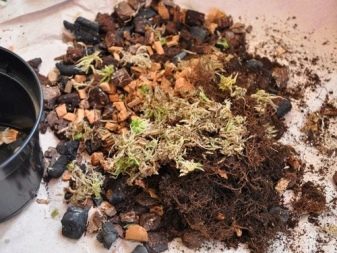
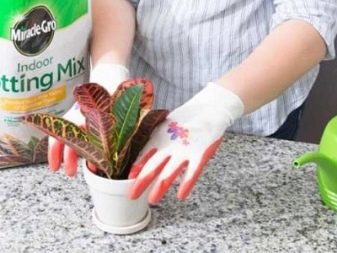
Before planting the plant, the prepared substrate should be disinfected, and the pot and drainage should be scalded with boiling water to destroy pathogenic microflora and eggs of insect pests. For the same purpose, several pieces of charcoal are added to the soil.
The planting capacity for codiaeum is taken of medium size, preferably shallow - this plant has a superficial root system and moisture stagnation may begin in the layers of soil mixture that have not been developed by roots, which has a most detrimental effect on the state of the green pet. The material from which the container is made does not matter at all, but it is better for a young flower to grow in plastic - it will be easier to transplant it as it grows. But for adult bushes, a container made of clay or ceramics is suitable - this is a heavy and stable material, it can withstand a rather massive crown of a flower and not fall.
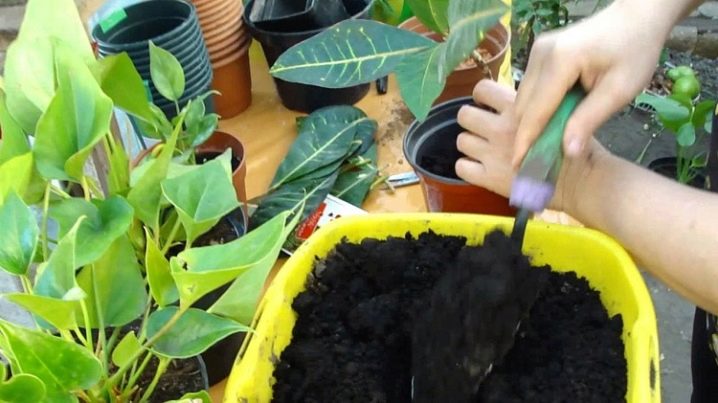
Popular varieties
Tamara Branch
Croton Tamara Branch has elongated leaves, shaped like feathers. The tips of the leaf plates are spiral. The color of the foliage is whitish-light green, like most varieties, spotted.

Variegatum
Codiaeum Variegatum is the ancestor of all cultural varieties of the genus. In the wild, it grows either as a shrub 1.5 m high or as a tree that rushes up 4 m. At the same time, it grows only up to half a meter on the windowsill.
Variegatum forms large leaves up to 30 cm long. Dense leafy plates are arranged alternately on the stem. Stem growth is very slow.
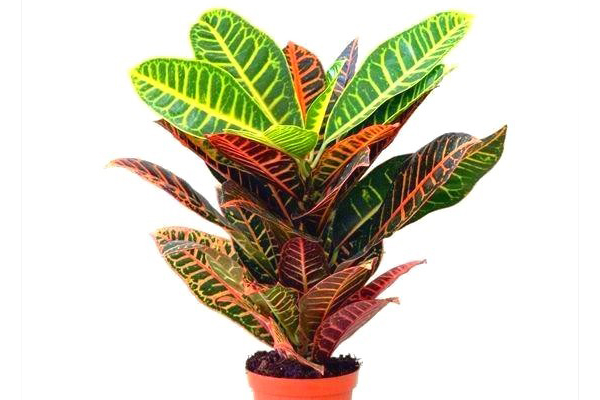
Zanzibar
Codiaum Zanzibar has thin and long leaves. The color of the leaf plate is not uniform, but most of it is colored green with small yellow dots.

Codiaum of Peter
The green plant with large yellow veins looks great. This compact bush grows up to half a meter in height. Large sinewy leaf plates grow alternately and are directed upwards. A special "accessory" is the bright yellow veins, which make the flower even more extravagant.
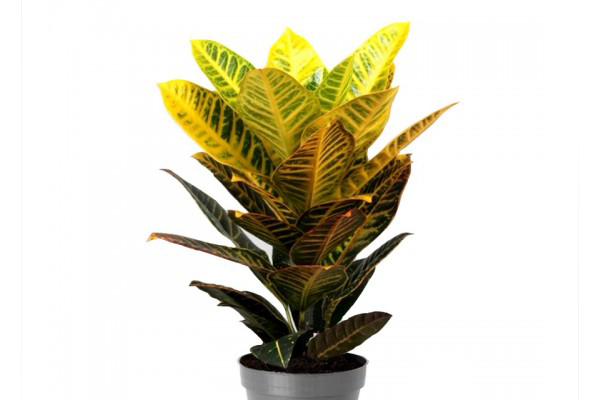
Mrs. Aiston
As an adult, it resembles a mini-tree. At a young age, the leaves have a delicate creamy shade. As they grow older, the leaves on the tree first acquire a yellow color, and then a bright green. Mrs. Aiston is striking in her originality, since all colors can be seen at the same time on one plant.
If the care of the plant is correct, then the whole tree will be covered with variegated foliage. The plant loves good lighting, but avoids direct sunlight, an extra portion of ultraviolet radiation can lead to burns.
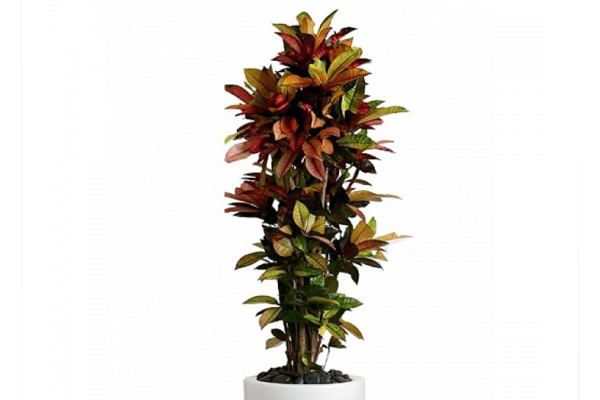
Excellence
This oak-leaved compact indoor flower looks unusual: a bright emerald top with yellow blurred spots, and below the leaves are crimson. Each leaf blade is clearly delineated with brown veins. The flower stands out not only for its original color, its leaves resemble oak in shape.
Perennial loves abundant watering. Water it when the top layer dries. Excess water is immediately removed from the pan to avoid root rot. This variety is the most popular among florists.
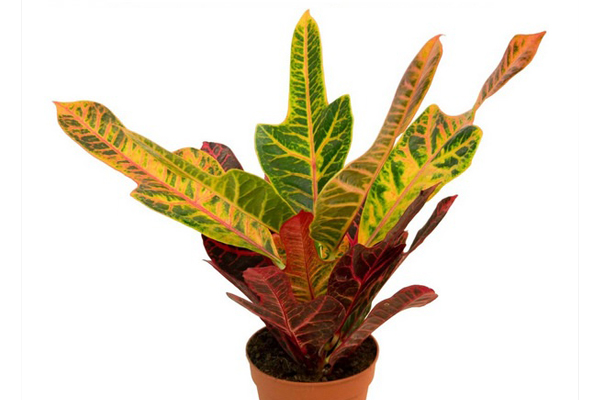
Mummy
Mammy's codiaum has narrow leaf plates, coquettishly twisted into spirals.The orange-red color of the leaves always cheers up, and the dark emerald stripes dividing the plate in two give the flower a certain intimacy.
Mummy looks bright. Yellow veins mixed with red ones add some severity to the leaves. Such a decorative element will adorn any interior.
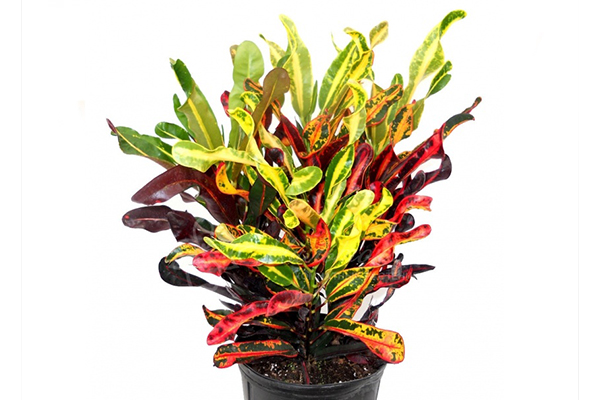
Sunny Star
The leaves are painted in warm sunny colors. The olive top and edging at the edges make the foliage more defined. Young leaves of Sunny old have a beige tint. As they "mature", they become scarlet and sunny yellow with pink splashes.
In insufficient light, the houseplant begins to stretch and loses its attractive variegated shades.
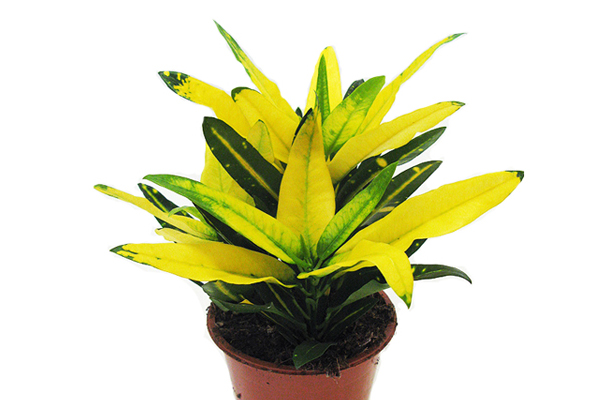
There are also other varieties:
- codium Mix. A variety that has many varieties. The mix with sharp edges on the tops of the leaves looks very original;
- decorative Gold sun with yellow veins on a green background is very picky about lighting;
- the elongated glossy leaves of the Golden Ring are decorated with a scattering of spots like gold;
- Gold Star looks like a branchy bush with green plates bordered with gold;
- a beautiful and unpretentious plant with narrow leaves Piktum Spot is ideal for an apartment;
- The Nervia variety is good for decorating a workplace, as it helps to achieve recognition and increases persistence;
- ornamental deciduous shrub Vilma is valued for its variety of variegated shades and unique leaf shape;
- the rare Eburneum variety is also called "white chimera", since the color of the leaf plates has a milky tint. As they grow older, the leaves turn pinkish;
- A spray of champagne has oblong thin leaves, on which, like a spray, small specks are located;
- the main decorative feature of Croton Aucubofolia is the color of the leaves. The plant blooms with delicate fluffy balls, which are collected in inflorescences. In order to enjoy the bright colors of Aucubofolia, bright lighting is needed.

